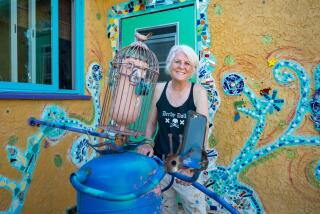Condors Keeping Their Distance From Fillmore
- Share via
Efforts to prevent more deaths of endangered California condors in Ventura County by luring them deeper into the Sespe Condor Sanctuary have failed so far, wildlife officials said Thursday.
But in what officials hope is a permanent behavior shift, the vultures have been staying within the boundaries of the sanctuary above Fillmore during the last week--away from the power poles that have killed at least one of the large birds.
“These birds tend to fixate in one spot for a while and then move on to somewhere else,” said Jennifer Gibson, a field biologist with the U.S. Fish and Wildlife Service. “It looks like they’ve had enough of Fillmore.”
Even so, biologists are trying to coax the condors farther into the sanctuary with calf carcasses and large black and white Mylar kites.
The kites, which have been flown for about a week, have not attracted any condors, but wildlife officials hope the carcasses will entice the birds.
“When they feed, they get so engorged they don’t move; they just sit there and burp for the rest of the day,” Gibson said. “While they are sitting around, we’re hoping they’ll be curious about the kites and go check them out.”
Just in case the condors end up flying back toward Fillmore, biologists who monitor them are carrying slingshots, Nerf balls and other gizmos to scare the birds away. On occasion they have resorted to shaking the power poles to keep the condors from perching.
“It doesn’t seem very sophisticated, but all you really need to do is startle the birds to get them to move,” Gibson said.
If the condors continue to stay away from the power lines, the Fish and Wildlife Service will abandon plans to trap and move the birds to the San Rafael Wilderness in Santa Barbara County, said Dave Ledig, assistant director for the California Condor recovery program.
Meanwhile, workers from Southern California Edison have begun installing jagged, triangular anti-perching devices atop six power poles in the area where two condors have been killed. In the past two years, the company has installed about 20 of the devices to discourage condors from roosting on the poles.
Two weeks ago a year-old female condor died after either colliding with a power pole or being hit by a car near California 126 east of Fillmore. In late May, another year-old female condor was electrocuted by a power line in the same area. A third condor died last October after swallowing antifreeze that had been dumped on the ground near Pyramid Lake.
Edison and other energy companies have also spent about $400,000 to bury 1.6 miles of the hundreds of miles of power lines within the condors’ flight path.
There are 76 California condors. All but the five in the Sespe sanctuary are in captivity--about half of them at the Wild Animal Park in San Diego County and half at the Los Angeles Zoo.
Regardless of the success in relocating the condors remaining in the wild, the U.S. Fish and Wildlife Service does not plan to release any more into the 46-year-old, 53,000-acre sanctuary.
In December, the service plans to release six more of the captive condors into the San Rafael Wilderness in Santa Barbara County.
Releasing the condors is part of a $15-million program to reintroduce the nearly extinct birds into the wild.
More to Read
Sign up for Essential California
The most important California stories and recommendations in your inbox every morning.
You may occasionally receive promotional content from the Los Angeles Times.













